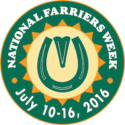Advertise Follow Us
American Farriers Journal

View Archived Issues
May/June 2016
Volume: 42
Edition: 4
American Farriers Journal is the “hands-on” magazine for professional farriers, equine veterinarians and horse care product and service buyers.
-
Table Of Contents
Table Of Contents
Contrary To Popular Opinion
Research indicates that the positive effects of particular shoe selection for Western Pleasure horses are guided by the perceptions of judges and trainers rather than realityRead MoreShoeing For A LivingFor the Love of Shoeing and Teaching
Ritner Goff emphasizes hard work and continuing education in his North Carolina multi-farrier practiceRead MoreUnderstanding And Managing Quarter Cracks
California farriers offer their advice to achieve positive outcomesRead MoreGetting to the Bottom of Toe Cracks
Understanding what causes the problem is critical to correcting itRead MoreLacing And Patching Cracks: Still Getting Horses Back Into Competition
Decades after Ian McKinlay patched his first crack, the New Jersey farrier still has success with the practice when the case dictatesRead MoreWhy Equine Bones Break and Tendons Rupture
Understanding anatomy and physics can help prevent severe injuriesRead MoreBoost Productivity With Better Scheduling
Plan a more efficient workday with these tips from experienced farriersRead MoreFarrier Q&A: May/June 2016
What are your criteria for selecting a pad to put on a horse? What type of pad and why?Read MoreBooknotes: An Unparalled Presentation Of Equine Anatomy
The Illustrated Horse’s Foot (A Comprehensive Guide)Read MoreTrimming To The Center Of Rotation
Wellington, Fla., farrier emphasizes the basics to evenly distribute stressRead MoreBe Part Of The Farriers Spotlight
We’re looking for more pictures and stories of our favorite hard workers for the 18th annual National Farriers WeekRead MoreNon-Metal Horseshoes: Knowing Why to Use Them is as Important as Knowing How
Flexibility, concussion dampening among benefits touted by developers and users of these productsRead MoreTest Aluminum’s Heat Before Working With It
Aluminum holds its heat well, but are you working it at the correct temperature?Read MoreCreating A Simple And Functional Workstation
California farrier maximizes time and money by converting air compressor trailerRead MoreResearch Journal: May/June 2016
The information, ideas and opinions expressed are those of the author and do not necessarily represent those of the United States Department of Agriculture.Read More -
Featured Articles
Featured Articles
Contrary To Popular Opinion
Research indicates that the positive effects of particular shoe selection for Western Pleasure horses are guided by the perceptions of judges and trainers rather than realityRead MoreTest Aluminum’s Heat Before Working With It
Aluminum holds its heat well, but are you working it at the correct temperature?Read MoreWhy Equine Bones Break and Tendons Rupture
Understanding anatomy and physics can help prevent severe injuriesRead More - Digital Edition
-
Online Extras
Online Extras



















